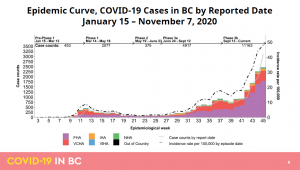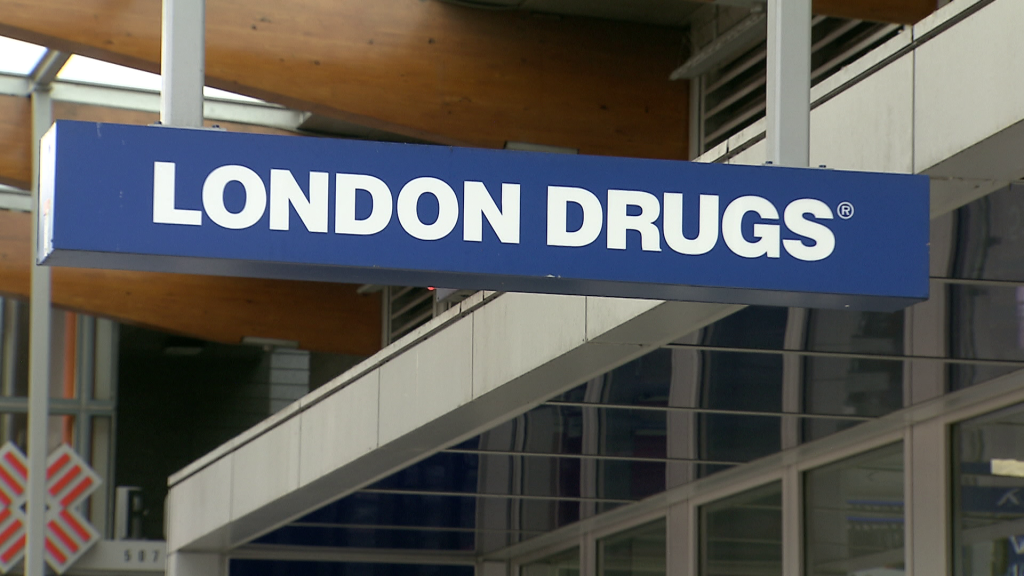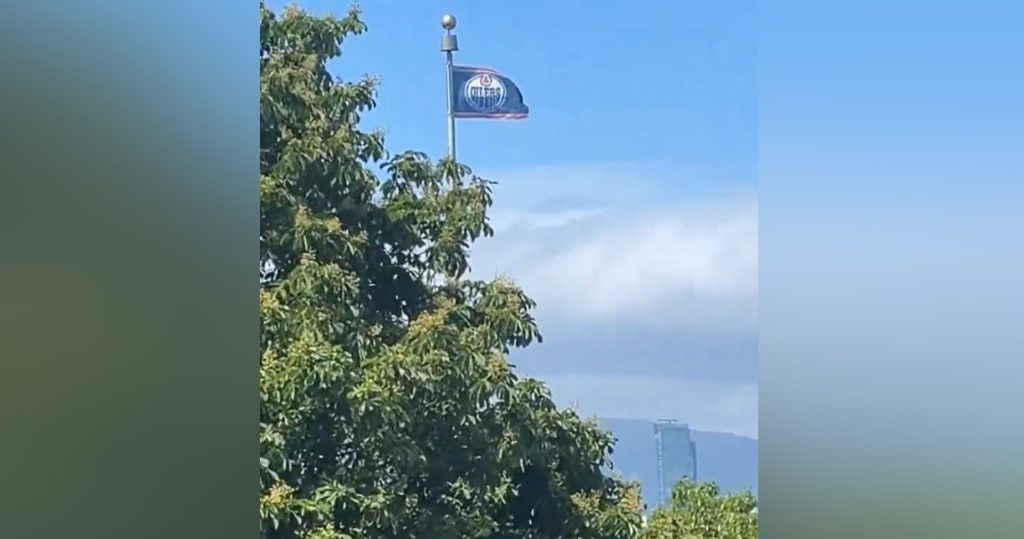Household, community transmission driving COVID-19 surge in B.C., new daily record
Posted November 12, 2020 3:53 pm.
Last Updated November 17, 2020 4:33 pm.
VANCOUVER (NEWS 1130) — The primary driver of COVID-19 transmission is gatherings in households and in the community — and cases have been doubling nearly every two weeks — according to provincial modelling data.
“As we have seen all along, the primary source where people are exposed is through their households or community interactions,” said Provincial Health Officer Dr. Bonnie Henry Thursday.
“We don’t put in those measures to keep us safe that we do in other settings.”
The break down of where transmissions are happening. Showing social interactions are at the base of most of them. Says schools/daycares seeing some cases but certainly not where most transmissions at all are happening. #bcpoli @NEWS1130 #covid19 #bced pic.twitter.com/dbbLL02Qqg
— LizaYuzda (@LizaYuzda) November 12, 2020
Control over COVID-19 is at risk of getting out of hand, with case numbers so high contact tracers are having a hard time keeping up. This coupled with challenges brought on by a change in weather it making that work challenging, Henry said.
Depending on how the next few weeks go, Henry said it’s possible the province will need to change strategies in order to stem transmission.
BC's #covid19 update Nov 12
4 death-289 total
536 Wed, 594 Thu
(highest new cases in a day – prev high 589 last friday)
20368 total
14089 Recovered
Active 5793 (5133)
Hosp/icu 155/44 (142/46) Prev high 149 in Apr
Monitor 11091 (9781) 1310+ since Tuesday#bcpoli @NEWS1130— LizaYuzda (@LizaYuzda) November 12, 2020
Prior to detailing the data, Henry announced 594 new COVID-19 infections over a 24-hour period between Nov. 11 and Nov. 12, a new daily record. Between Tuesday and Wednesday, 536 cases were reported. On both days, the vast majority of the cases were in the Fraser Health region.
Four more people have died from the virus, Henry added. One person was an elderly person in the community, the other three were residents in long-term care homes.
Six outbreaks in healthcare facilities were also confirmed Thursday, while three are now over.
Henry pointed out how quickly the curve wave flattened after the first wave of the coronavirus in the new data. She contrasted that promising trend with what’s been happening over the past few weeks during which cases have spiked, especially in the Fraser and Vancouver Coastal Health regions.

Hardest hit regions near limit
This month’s modelling data breaks cases down by region and city, though Henry notes the geographic distribution does not say where the transmission happened — only where the patient lives.
“It reflects that the intensity of transmission really is concentrated, particularly in the last few weeks, in the Fraser and Vancouver Coastal Health region.”
Throughout the pandemic, the majority of B.C.’s infections have been in the Vancouver Coastal and Fraser Health regions, which are currently under temporary COVID-19 restrictions.
We are back up again at R +1. DBH says were there before thanksgiving and bent it down — now way up again. But clear main challenge is in Fraser and VCH. But seeing clusters, increases in other regions as ppl travel to metro and back.#bcpoli @NEWS1130 #covid19 #bced pic.twitter.com/gtQaxmXKS1
— LizaYuzda (@LizaYuzda) November 12, 2020
“We were doing a good job of finding people stopping that next chain of transmission. In the last few weeks, that has become way more challenging, particularly in the Vancouver Coastal and Fraser health regions. And this is reflected again, in a dramatic increase in our numbers of hospitalizations,” Henry said.
Hospitalizations are back above peak spring numbers. As of Thursday, 155 patients are in hospital because of the virus, with 44 in intensive care.
Hospitalizations by region also show the pressure metro vancouver is under – @Fraserhealth and @VCHhealthcare.
Staggering the cases there vs anywhere else in BC#bcpoli @NEWS1130 #covid19 pic.twitter.com/uYkMDpm8LC— LizaYuzda (@LizaYuzda) November 12, 2020
As much as contact tracers are working to curb transmission, “we’re reaching our limits,” Henry said.
Change in season means change in plans
Safety plans have changed as the pandemic persists, Henry said, and that’s not only because there is a greater understanding of the virus.
With summer gone, the things that worked to contain the spread of the virus then just don’t apply anymore.
“We’re learning that it doesn’t spread as well when temperatures are warmer when humidity is is as lower, but as we move into what we call our respiratory season or cough and flu season, we’re finding that this virus finds it easier to transmit it partly because we’re indoors more, but also because the weather conditions so the climate conditions make it easier for the virus to spread.”
As a result, it’s taking longer to follow-up on positive infections and carry out contact tracing.
Comparing BC to other regions and countries…#bcpoli @NEWS1130 #covid19 #bced pic.twitter.com/bU9UU9Qsdj
— LizaYuzda (@LizaYuzda) November 12, 2020
“We need everybody to pay attention now,” Henry said. “These are the times now to review those plans in light of the increased transmission in our community. And what we are learning about this virus, as we go into this season.”
How far COVID-19 can go?
To emphasize how far-reaching the virus can be, Henry broke down examples of transmission, noting that every 13 days COVID-19 cases are doubling.
“From just one positive COVID-19 employee, and then the industrial setting, 48 additional people became positive in that worksite,” she said. “One of those people was admitted to hospital, seven other people became positive after interacting with one of those workers, 46 household contacts were affected. So people went home and their household members had to be isolated, they couldn’t go to work, they couldn’t go to school, because they were close contacts of the case. And there were 111 people who are unable to go anywhere for two weeks because of their exposure.”

Four more worksites were put at risk because of the seven infected people.
“We need to get our social interactions back to those levels where our public health contact tracing can control the spread. That is in our hands to do,” Henry said.
Miss the update? Watch it here:
Read the full report:
CovidModellingBriefing_20201112







